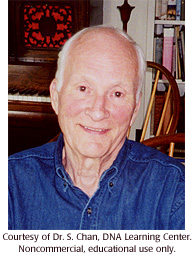Concept 21 RNA is an intermediary between DNA and protein.


 Paul Zamecnik developed a cell-free extract that he and Mahlon Hoagland used to study protein synthesis. They identified tRNA as the adaptor predicted by Francis Crick in his Central Dogma. Sydney Brenner showed that mRNA was the unstable intermediate that carried the message from DNA to the ribosomes.
Paul Zamecnik developed a cell-free extract that he and Mahlon Hoagland used to study protein synthesis. They identified tRNA as the adaptor predicted by Francis Crick in his Central Dogma. Sydney Brenner showed that mRNA was the unstable intermediate that carried the message from DNA to the ribosomes.
Mahlon Hoagland (1921- 2009)

Mahlon Hoagland was born in Boston. His father was a research scientist with an interest in neurobiology. His dedication and passion for his work both drew and repelled the younger Hoagland, who learned first-hand what it was like to be a scientist. Hoagland knew fairly early on that he wanted a profession but wasn't sure that he wanted to be a scientist.
Hoagland decided he would be a medical doctor so as not to be in direct competition with his father. He went to college, first Williams College and then transferred to Harvard after a year. World War II had just started and with the need for medical doctors, Hoagland entered medical school even before graduating from college. He found he had the aptitude for being a surgeon ? he was manually adept and anatomy was one of his favorite classes. Unfortunately, three months before graduation, Hoagland was diagnosed with tuberculosis. He was sent to the Trudeau Sanatorium at Saranac Lake ? the same one where Phoebus Levene stayed ? for the classic bed rest cure. Treatment of tuberculosis with antibiotics wasn't available until near the end of his stay and by that time, Hoagland was deemed healthy enough.
In 1947, Hoagland returned to Harvard Medical School to finish his interrupted year. He still wanted to become a surgeon and applied to work as a surgical intern after graduation in 1948. It was soon obvious that he needed a less taxing career; after only weeks, Hoagland reactivated his tuberculosis. Disappointed, Hoagland applied for a postdoctoral position with Dr. Joseph Aub, the director of the Huntington Laboratories at Massachusetts General Hospital.
At Huntington, Hoagland learned to be a scientist. He worked on the effects of beryllium on enzymatic activity and in the process became more interested in biochemistry and the protein synthesis work going on in Paul Zamecnik's lab. Hoagland arranged sabbaticals to learn more about biochemistry with the goal of working in Zamecnik's lab on his return.
In 1953, Hoagland started work in Zamecnik's lab on the problem of amino acid activation. Using Zamecnik's cell-free system, Hoagland worked out the mechanics and published his results in 1955. He then began working on a project that Zamecnik had put on hold. This led to the discovery of tRNA, the adaptor (predicted by Francis Crick) that shuttles amino acids to messenger RNA. The results were published in 1957 and served to connect two fields of science research, biochemistry and molecular biology.
Hoagland spent 1958 at Cambridge University and worked with Francis Crick to try and use tRNA to solve the genetic code. He returned to the U.S. as associate professor of microbiology at Harvard Medical School. In his seven years at Harvard, Hoagland found great satisfaction in teaching and was distressed at the lack of "teachers" among the scientists who were only interested in research. He left Harvard to accept a position at Dartmouth Medical School where he improved the biochemistry curriculum.
In 1970, Hoagland accepted the directorship of the Worcester Foundation, the institute founded by his father. Hoagland was able to attract new researchers and established and strengthened research programs in cell biology, endocrinology, neurobiology, and reproductive biology at Worcester. In 1980, he was successful in recruiting Paul Zamecnik.
After Hoagland retired, he maintained a strong interest in education and teaching. Over the years, he wrote a number of "non-scholarly" books on the subject of genes and molecular biology. The Way Life Works was re-edited as a successful textbook for high school biology classes and the interested public. Hoagland had a life-long hobby of creating art by carving and sculpting wood.


Mahlon Hoagland's father was a research scientist, and founded the Worcester Foundation for Experimental Biology, the institution where, among other things, the birth control pill was developed.

Hoagland and Zamecnik were identifying the molecules and the energy requirements of protein synthesis reactions. Would it have been easier if they had known about Francis Crick's adapter hypothesis?
 DNA and proteins are key molecules of the cell nucleus.
DNA and proteins are key molecules of the cell nucleus. One gene makes one protein.
One gene makes one protein. A gene is made of DNA.
A gene is made of DNA. Bacteria and viruses have DNA too.
Bacteria and viruses have DNA too. The DNA molecule is shaped like a twisted ladder.
The DNA molecule is shaped like a twisted ladder. A half DNA ladder is a template for copying the whole.
A half DNA ladder is a template for copying the whole. RNA is an intermediary between DNA and protein.
RNA is an intermediary between DNA and protein. DNA words are three letters long.
DNA words are three letters long. A gene is a discrete sequence of DNA nucleotides.
A gene is a discrete sequence of DNA nucleotides. The RNA message is sometimes edited.
The RNA message is sometimes edited. Some viruses store genetic information in RNA.
Some viruses store genetic information in RNA. RNA was the first genetic molecule.
RNA was the first genetic molecule. Mutations are changes in genetic information.
Mutations are changes in genetic information. Some types of mutations are automatically repaired.
Some types of mutations are automatically repaired.